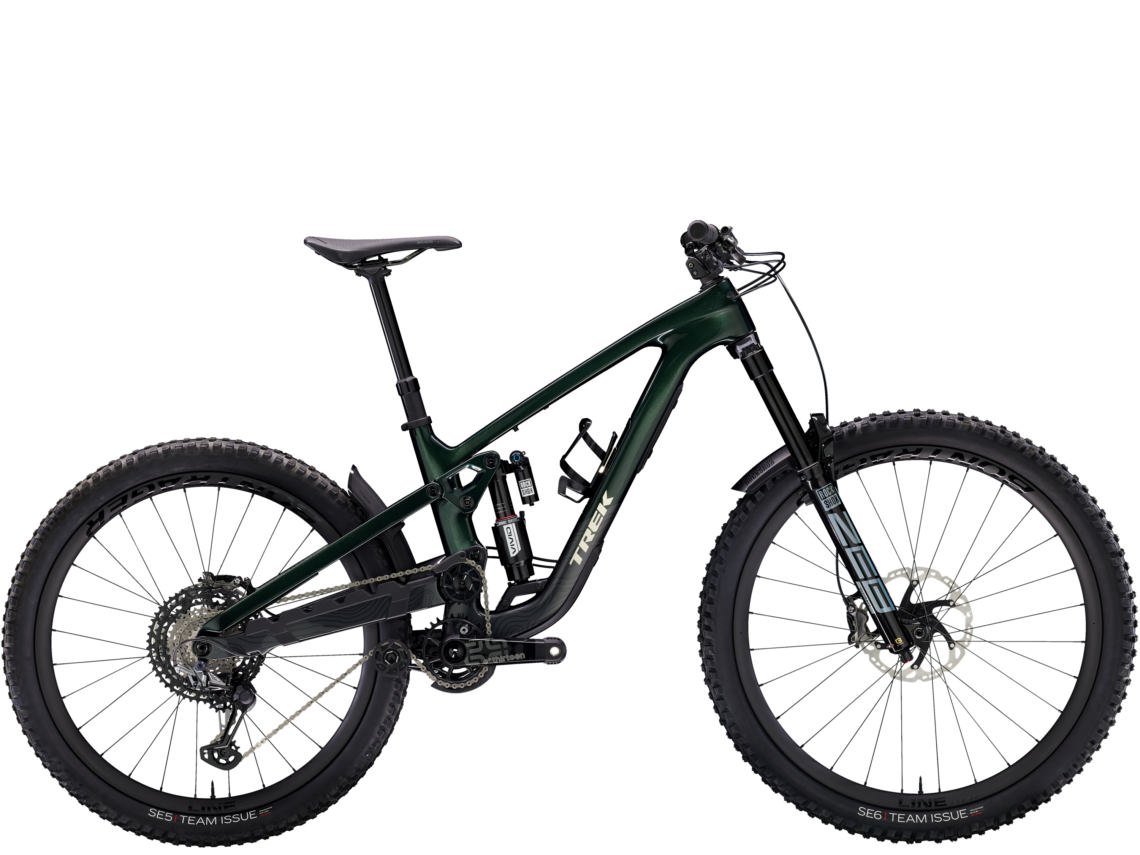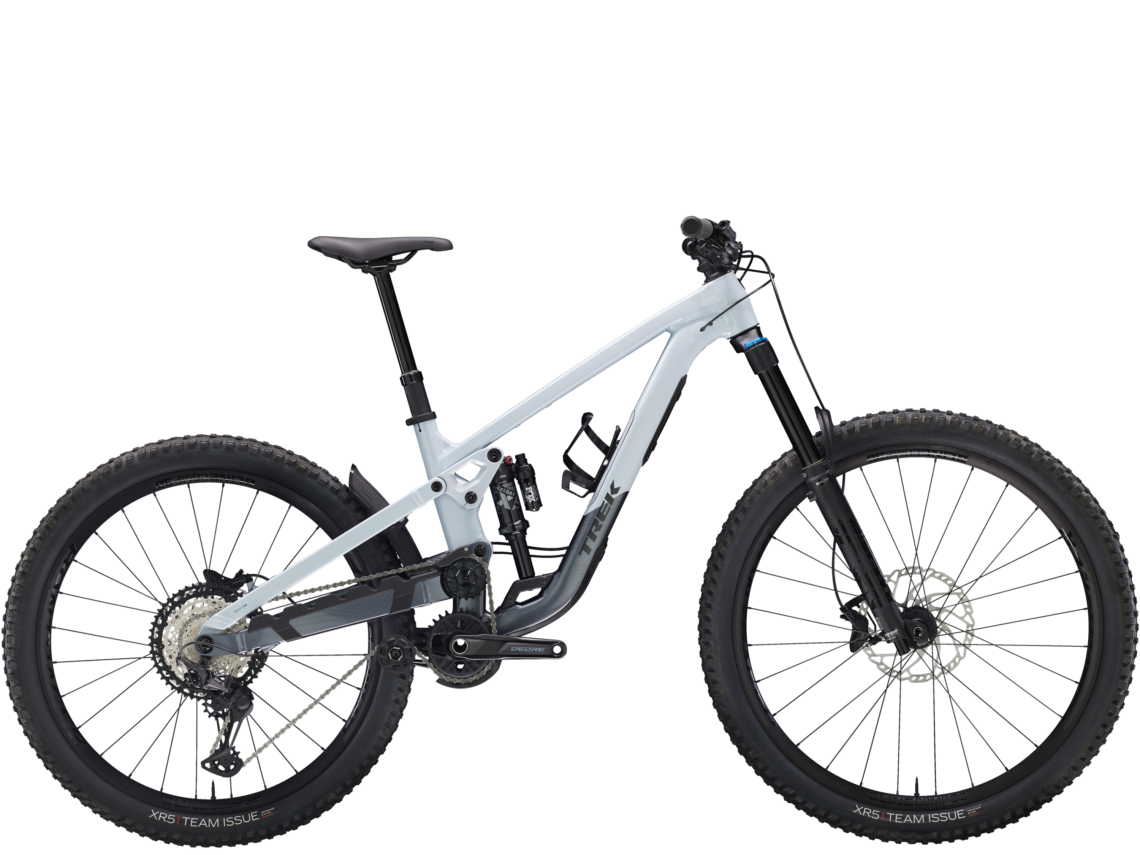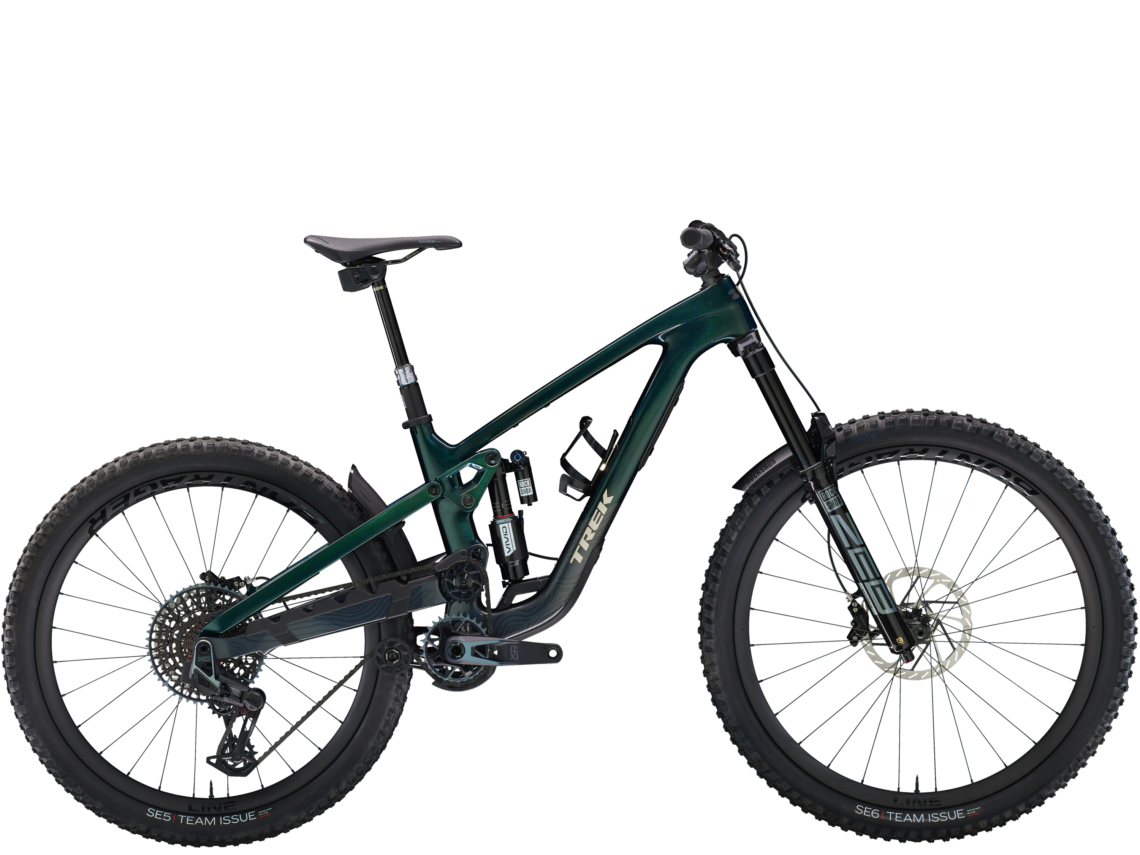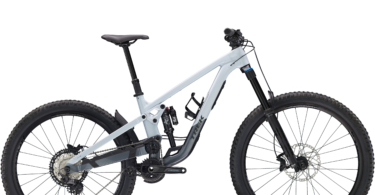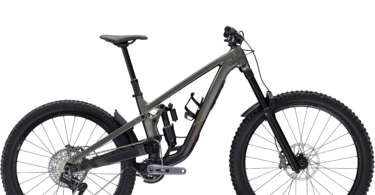The new 2024 Trek Slash is right on trend: high pivot rear suspension, mullet wheel set-up, generous amounts of travel and plenty of adjustment options. Furthermore, it combines both familiar and newly developed features that are meant to simplify your riding experience. After six weeks of testing on both sides of the pond, we were able to gather countless impressions, both good and not so good.
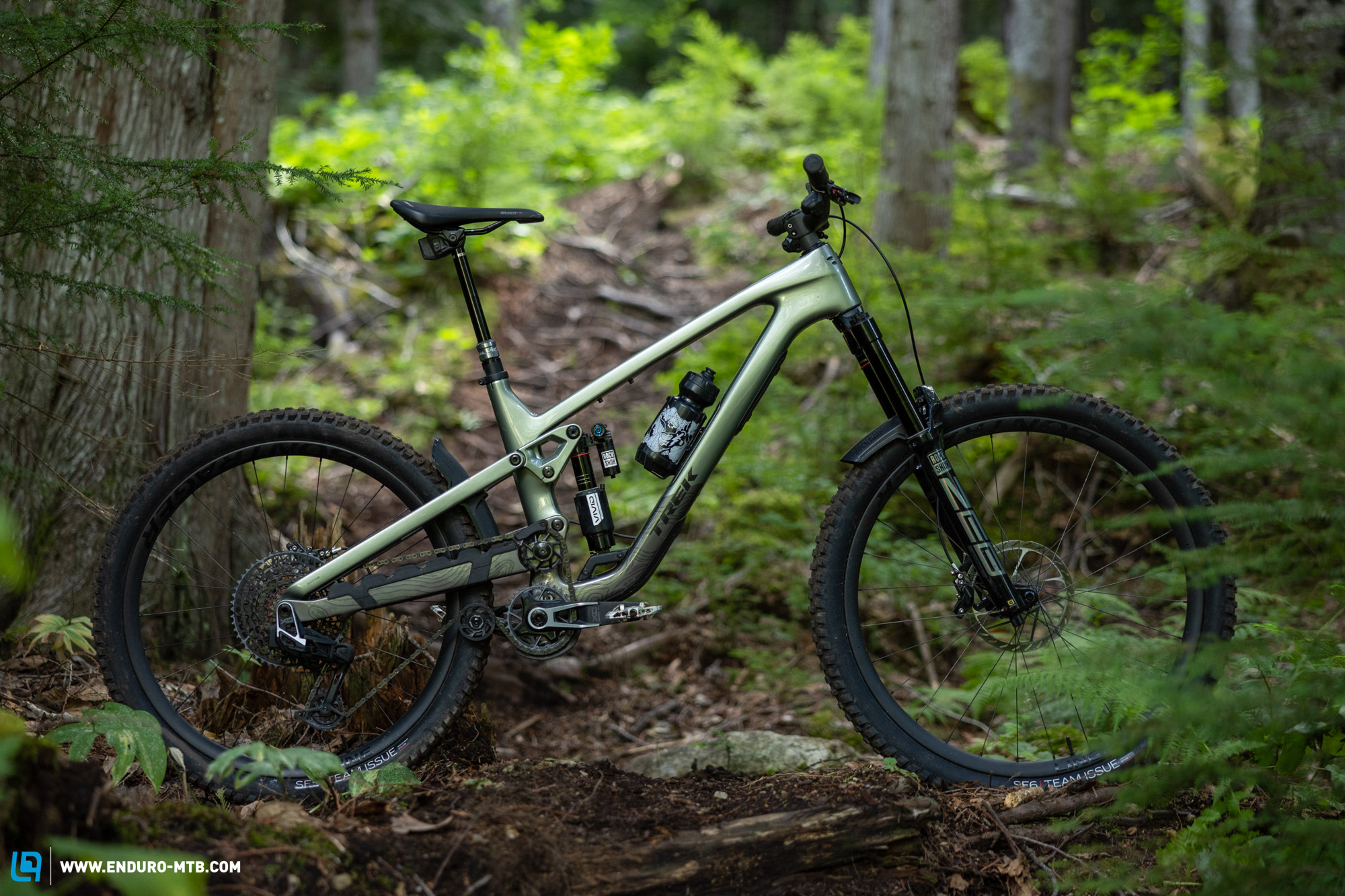
The Slash has been an integral part of Trek’s portfolio for over 10 years, and is now entering its 6th generation. The most significant innovation is the new rear suspension, which relies on a high pivot design and generates a very generous amount of travel, bringing the Slash in line with the latest generation of enduro bikes. Up until now, Trek have only used the high pivot system on their downhill bike, the Session, which nevertheless allowed them to gather lots of practical experience with the system and use their World Cup riders’ feedback to develop the new enduro rig. The new Slash generates 170 mm of travel both front and rear, and rolls out of the factory sporting a mullet. An interchangeable shock mount, however, allows you to convert it to a full 29er. As usual, Trek are releasing both an alloy and a carbon version of the new Slash, both of which are available in several different spec variants. We’ve already put the new Trek Slash 9.9 XO AXS 2024 through the wringer over a 6 month period, dipping its tires both into Canadian and European soil to gather some exciting insights.
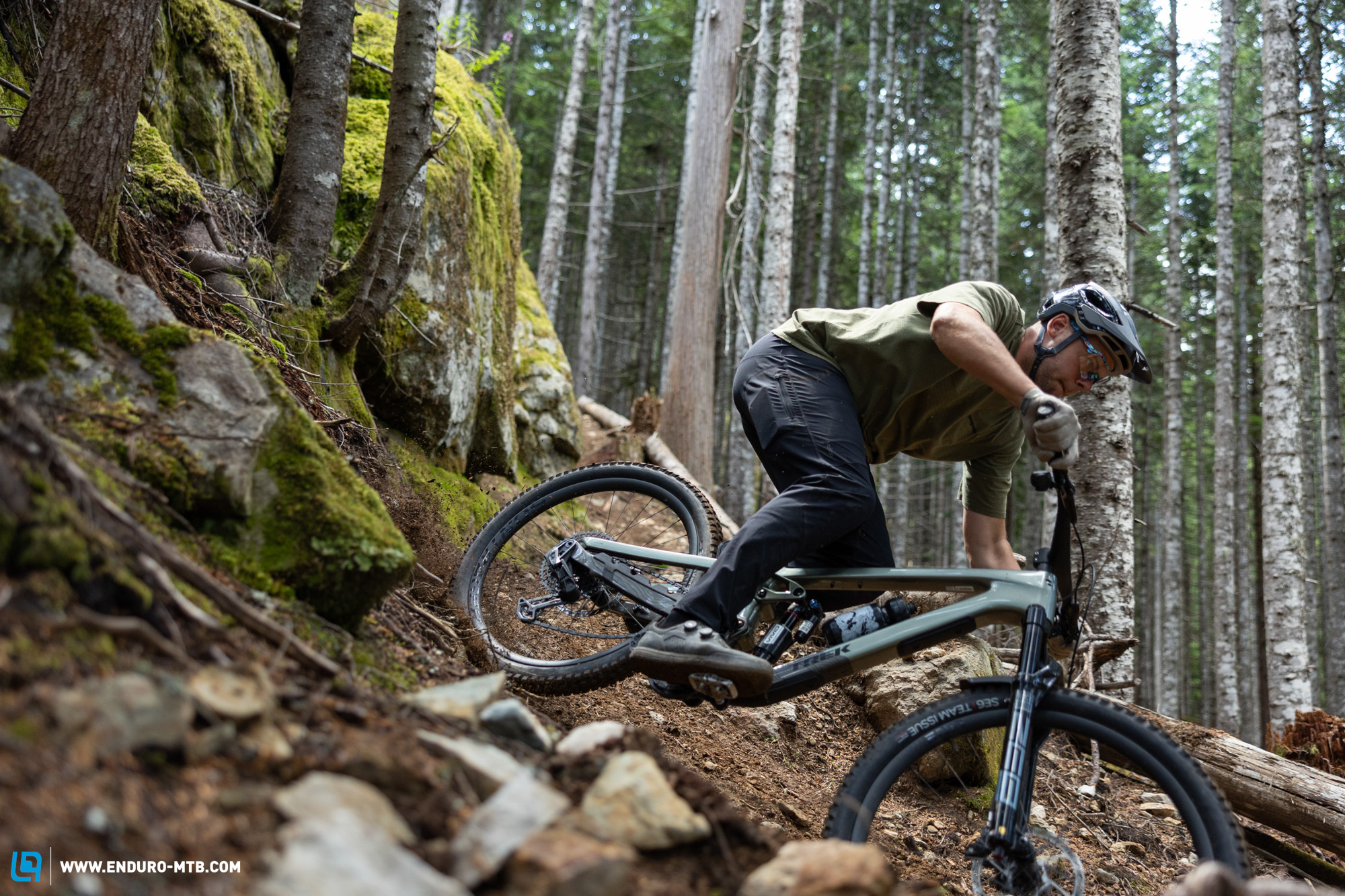
The detail solutions of the new 2024 Trek Slash
The predecessor of the 2024 Trek Slash already came with a practical storage compartment integrated into the down tube, which Trek has updated for the latest Slash iteration. The opening is much bigger, making it easier to reach all the trail essentials you store inside it. Moreover, the edges of the compartment are still framed with a plastic liner, preventing you from cutting your fingers or damaging the contents when you pull them out of the compartment. The alloy frame has a storage compartment too and all models come standard with a small pouch for all your trail essentials, which can be easily pulled out of the frame using the bright red Cordura tab. The closure system relies on a simple lever that disappears under the bottle cage when engaged, and is easy to operate even while wearing gloves. The cables of the new Slash are routed internally and only reappear briefly at the transition from the main frame and swingarm. The cable ports are in a rather unusual position, sitting prominently on the front of the head tube – this look takes some getting used to! In combination with a wireless drivetrain, Trek close the cable ports with small rubber plugs.
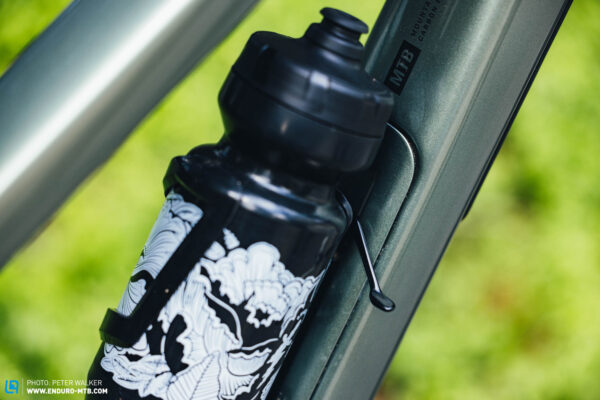
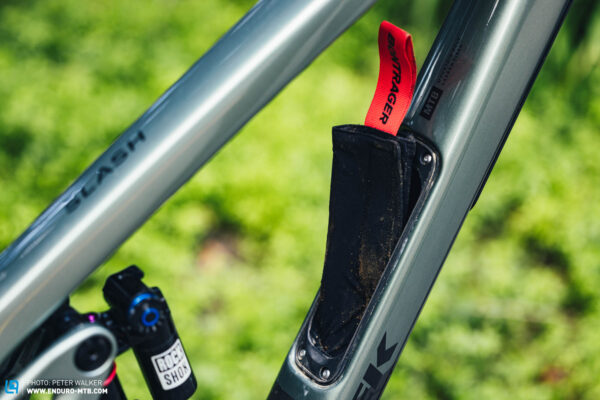

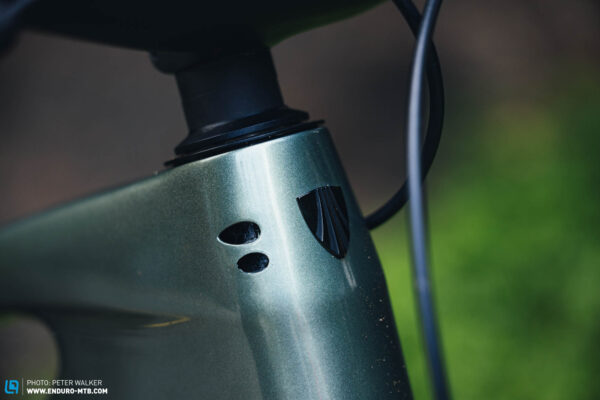
There’s an additional tool mount underneath the top tube, which allows you to carry a spare inner tube or a tool strap, for example. In typical Trek fashion, the new Session comes standard with an integrated Bontrager BITS mini tool in the steerer tube, which includes all of the basic tools required for essential trailside repairs. That said, removing the tool from the steerer tube requires strong fingers and, as usual, the lever of the closing mechanism rattles on the trail. Trek also hide a 6 mm Allen key in the rear thru-axle.
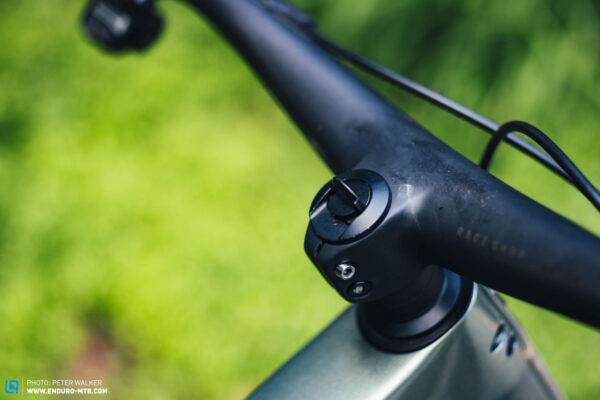
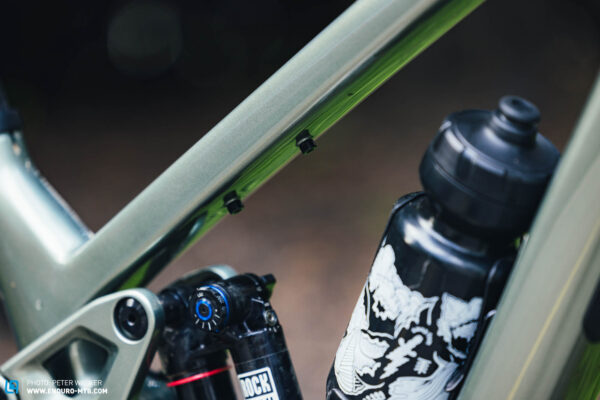

For model year 2024, Trek provided the Slash with several protective features, all of which are meant to preserve the bike’s value. Amongst them is the generously sized integrated mudguard, which is bolted directly to the seat stay and is meant to protect the seat tube from stray rocks. Unfortunately, this has to be removed if you want to swap the 27.5” rear wheel for a bigger 29″ rear wheel. Furthermore, the down tube comes standard with a pair of dual-density TPU plates, which allow you to replace the inner section if it gets damaged. In addition, the frame comes with an additional protective layer under the final finish. Trek also redeveloped the chainstay protector from the ground up, raising both the inner and outer edges to prevent chain slap more effectively – and this really works, ensuring a quiet ride on the trail.
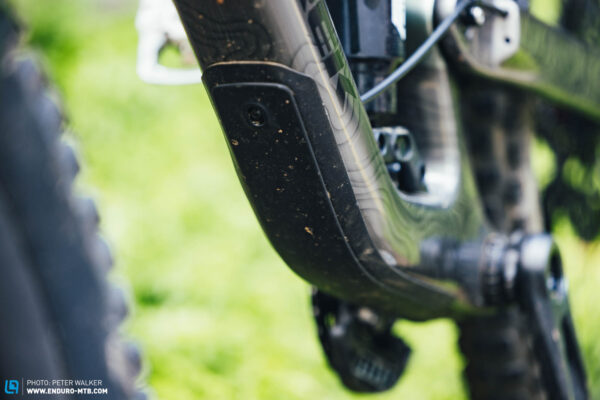
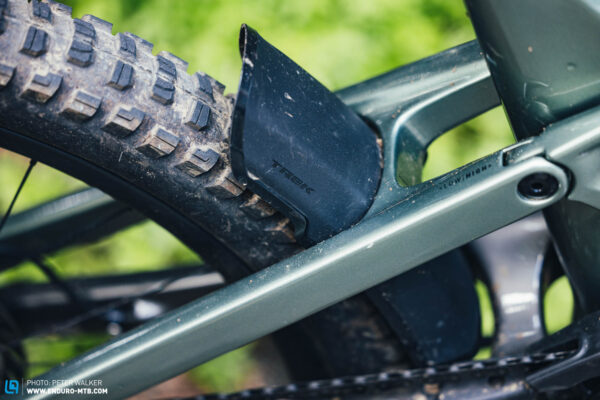
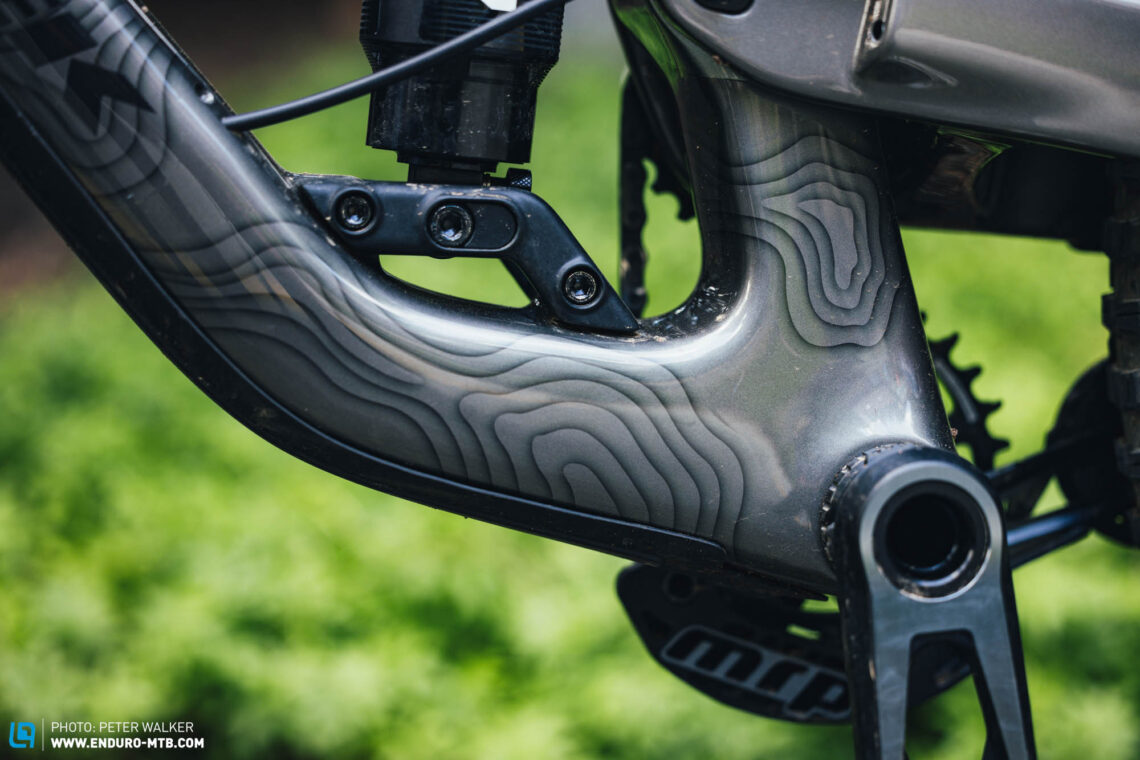
The high-pivot rear suspension of the new 2024 Trek Slash
While the new 2024 Trek Slash 2024 still relies on the same linkage-driven single pivot rear suspension, it combines it with a high pivot point design. This positions the main pivot point well above the chainring, allowing the rear wheel to swing up and backwards during an impact. This rearward axle path can help to make the suspension feel smoother over square-edged hits, ironing out roots and rocks more efficiently. However, the system also has its drawbacks: as the axle moves rearwards through the travel, the distance between the cassette and chainring grows, resulting in wheelbase and chainstay growth. This pulls the chain backwards, manifesting in high levels of pedal kickback and resulting in an imbalanced weight distribution of the rider on the bike throughout the travel. To counteract this, a chain idler pulley is fitted on the seat tube, which helps minimise pedal kickback and also gives high-pivot bikes their characteristic look. This also allows the engineers to fine tune the bike’s anti-squat and anti-rise levels independently simply by moving the position of the idler pulley. The unusually big 19T idler pulley is meant to mitigate the negative effect that the high pivot system has on pedalling efficiency, because the bigger pulley has a wider radius. Furthermore, Trek use a small chain guide to prevent the chain from falling off the idler.
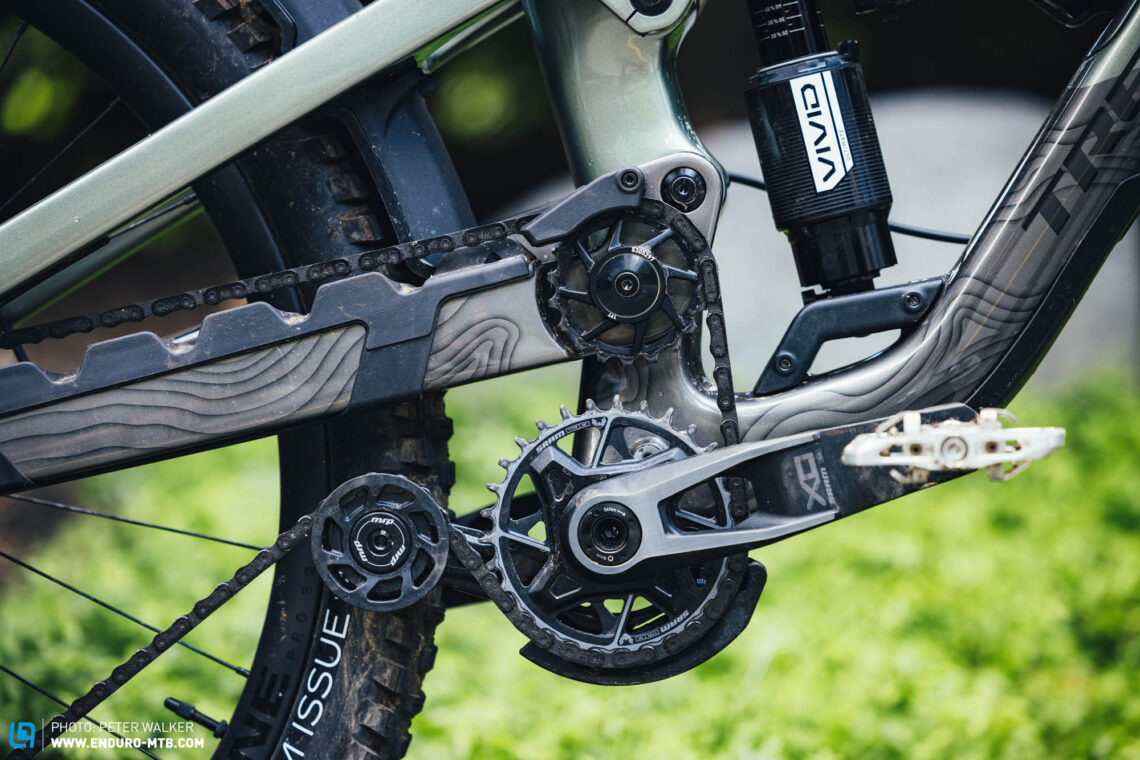
The new 2024 Slash also features an additional pulley below the chainstay, which isn’t that common with high pivot bikes. This special pulley also includes an MRP bash guard and can be retrofitted to other high pivot bikes. Its job is to prevent the chain from stretching under the chainstay and thus to stop it from pulling on the rear derailleur. That said, even with the biggest XL frame, the chain runs at a sharp angle in the lowest gears, as the distance between the rear derailleur cage and the idler pulley is very small. While this didn’t cause us any problems on the trail, we’re not sure how good this is, both for pedalling efficiency and the chain’s service life. Speaking of the chain, with all frame sizes up to L, you’ll get away with a conventional 126-link chain. The new Slash in XL, however, requires 128 links, meaning that you need two chains.
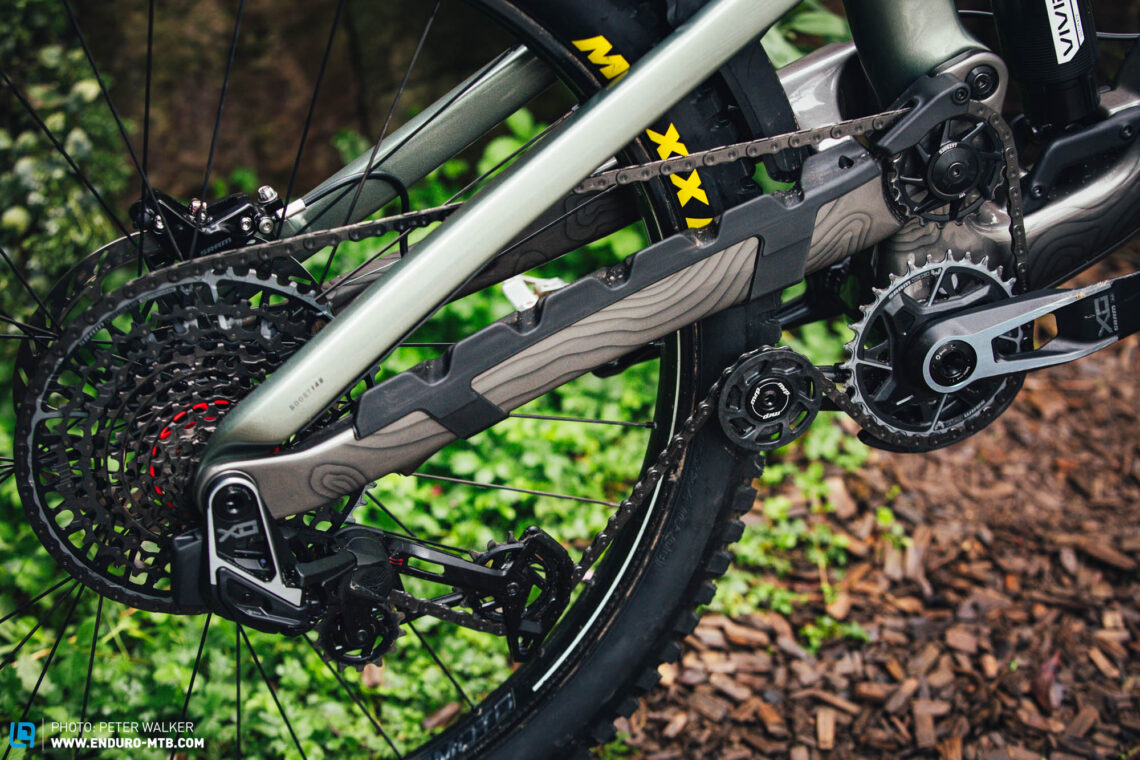
The new 2024 Slash still relies on Trek’s proprietary Active Breaking Pivot or ABP technology, which can be found on most of their full suspension bikes and is designed to keep the rear suspension active even under heavy braking, helping to maintain traction.
The spec of our test bike – The Trek 2024 Slash 9.9 XO AXS
Our Trek Slash test bike comes equipped with Rockshox Ultimate suspension consisting of a 170 mm ZEB Charger 3.0 fork with independently adjustable low- and high-speed compression damping, and a brand-new Vivid Ultimate air shock, which offers externally adjustable compression and rebound settings as well as a climb switch. Unlike the Super Deluxe, the new Vivid relies on a high-volume air chamber and Rockshox’s new proprietary Touchdown damper. Unlike the rest of the Trek range, the Slash doesn’t use a Thru Shaft damper, which comes standard with most of their full-suspension bikes and is developed specifically for Trek.
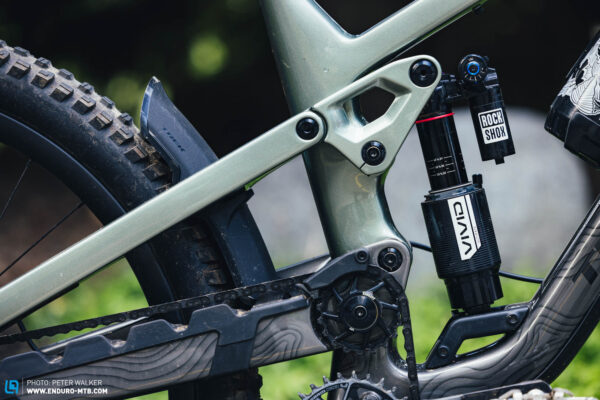

As the name extension suggests, the 2024 Trek Slash 9.9 XO AXS employs a new electronic SRAM X0 Eagle Transmission drivetrain. The rear derailleur mounts directly to the thru-axle and worked flawlessly throughout our test. SRAM also supply the wireless, electronic Reverb AXS dropper post, but this only offers a meagre 170 mm of travel, which is far too little for a modern enduro bike. However, there isn’t a longer-travel version of the Reverb AXS dropper, so we recommend swapping the standard dropper for a cable-operated model if needed. Given the seat tube’s generous insertion depth, you could even push a 240 mm OneUp Components V2 dropper post all the way into the frame of a Slash in size L. Needless to say, the brand-new drivetrain is complemented with SRAM’s four-piston Code Stealth Silver brakes, which, just like the old RSC model, feature tool-free lever reach and bite point adjustments as well as SRAM’s proprietary SwingLink lever for optimal modulation. Compared to the Stealth Ultimate flagship model, the Silver variant only forgoes the carbon levers, tipping the scales at just 8 g more. Due to the new design, the brake lines run parallel and close to the handlebars, which ensures a cleaner look but can cause the cables to rattle – this can be easily fixed with a couple of additional clamps or zip ties ;) The brakes are paired with 200 mm rotors front and rear, which suit the Slash’s character and field of application rather well! For more oomph, you can can upgrade to 220 mm rotors both front and rear, because both the frame and fork are approved for it.
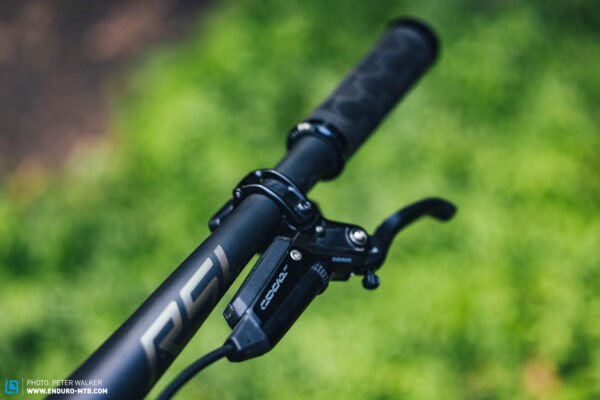
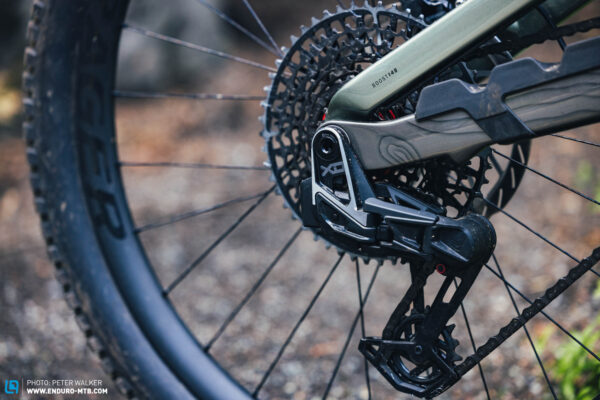

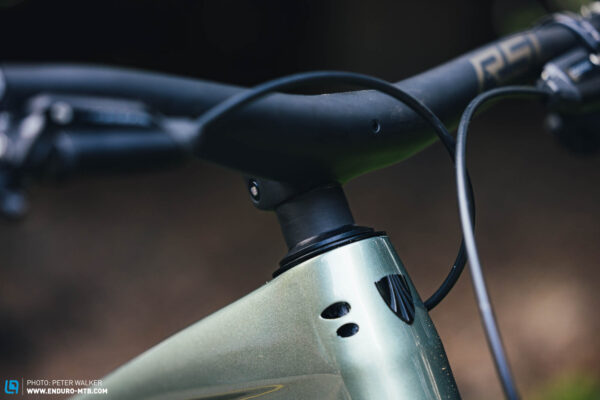
For the rest of the spec, Trek rely on their in-house component brand Bontrager, including a Bontrager Line Pro 30 carbon wheelset, which didn’t survive the testing sessions unscathed, with several spokes snapping after just 3 weeks of deployment. In addition, the rims are paired with flimsy, puncture-prone tires, which force you to run higher air pressure to avoid burping and snake bites. We recommend upgrading the standard Bontrager SE6 and SE5 tires for more robust tires before you start riding. In this test, we swapped to tires with a tougher DH casing after just a few laps. For the cockpit, Trek rely on an 820 mm Bontrager RSL one-piece handlebar/stem unit, which might look fancy but doesn’t allow for fine tuning except for the stem height, which can be changed using spacers. On top of that, the handlebars are very stiff and get even stiffer if you shorten them, like we did! With such a potent enduro bike, an adjustable cockpit makes more sense because it allows you to adapt the front end ergonomics to your anatomy. With the standard spec, our 2024 Trek Slash 9.9 XO AXS test bike in size L tips the scales at 15.7 kg.
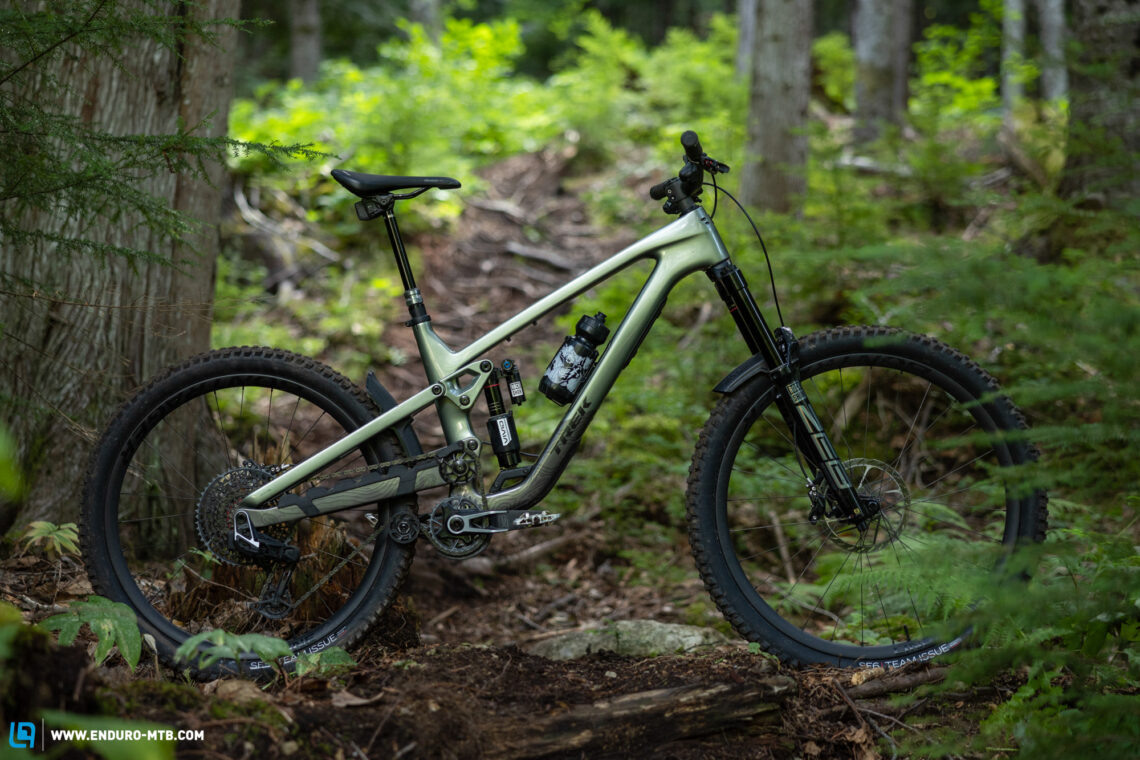
Trek Slash 9.9 X0 AXS 2024
Specifications
Fork RockShox ZEB Ultimate 170 mm
Rear Shock RockShox Vivid Ultimate 170 mm
Seatpost RockShox Reverb AXS 170 mm
Brakes SRAM CODE Silver 200/200 mm
Drivetrain SRAM Eagle Transmission X0 1x12
Stem Bontrager RSL 35 mm
Handlebar Bontrager RSL 820 mm
Wheelset Bontrager Line Pro 30 29"/27.5"
Tires Bontrager SE6 Team Issue/ Bontrager SE5 Team Issue 2.5"/2.4"
Technical Data
Size S M M/L L XL
Specific Features
storage compartment
Flip Chip
Toolmount
More spec variants of the 2024 Trek Slash
As already mentioned, the new 2024 Trek Slash is available both with an alloy and carbon frame. That said, none of the alloy versions comes with a high-end spec, meaning that you have to order the frame kit if you want to combine an aluminium frame with top-tier suspension, for example. Prices for complete builds range between € 4,499 and € 12,499, and the bikes should be already available from all official Trek dealers. The American manufacturer also lets you test ride their bikes in one of their “Test-a-Trek Centres”. Starting today, you can test the new Slash in Lenzerheide, Saalbach and Sölden.

The alloy version of the new Slash is available in two spec variants. The entry-level Slash 8 XT model comes equipped with a FOX 36 Rhythm fork and a hybrid Shimano XT/SLX drivetrain. Shimano also supply the four-piston Deore M6100 brakes. The Slash 9 GX relies on higher quality RockShox Select+ suspension and SRAM’s new electronic GX Transmission drivetrain, with matching SRAM Code Bronze four-piston brakes. The Slash 9.8 GX combines the same identical spec with a carbon frame.
The flagship Slash 9.9 XX model comes equipped with electronic RockShox Flight Attendant suspension, electronic SRAM XX Transmission drivetrain and wireless RockShox Reverb seatpost. The rest of the spec consists exclusively of top-tier components and plenty of carbon bling. However, all the fancy components come at a price – an eye watering € 12,499! However, Trek have released a total of 5 carbon variants, offering a suitable option for all sorts of wallets.
| Model | Frame material | Price |
|---|---|---|
| Slash 8 XT | Alloy | € 4,499 |
| Slash 9 GX AXS T-Type | Alloy | € 5,499 |
| Slash 9.8 GX AXS T-Type | Carbon | € 7,999 |
| Slash 9.8 XT | Carbon | € 7,999 |
| Slash 9.9 X0 AXS T-Type | Carbon | € 9,999 |
| Slash 9.9 XTR | Carbon | € 11,499 |
| Slash 9.9 XX AXS T-Type | Carbon | € 12,499 |
| Slash AL Frameset | Alloy | € 3,199 |
| Slash C Frameset | Carbon | € 4,999 |
The geometry of the new 2024 Trek Slash
The new Trek Slash 2024 will be available in 5 sizes, S to XL, and there’s also an intermediate size called M/L. All models in size S feature a curved top tube and 27.5″ wheels front and rear. From size M onwards, the new Slash rolls on a mixed wheel setup with a 29″ wheel at the front and smaller 27.5″ wheel at the rear. However, from size M upwards you can also use a 29″ rear wheel using a different shock mount, but this has to be bought separately and isn’t included in the frameset. The optional shock mount comes with a flip chip that allows you to change the progression of the rear suspension from 20% to 25%, which is intended for coil shock conversions.
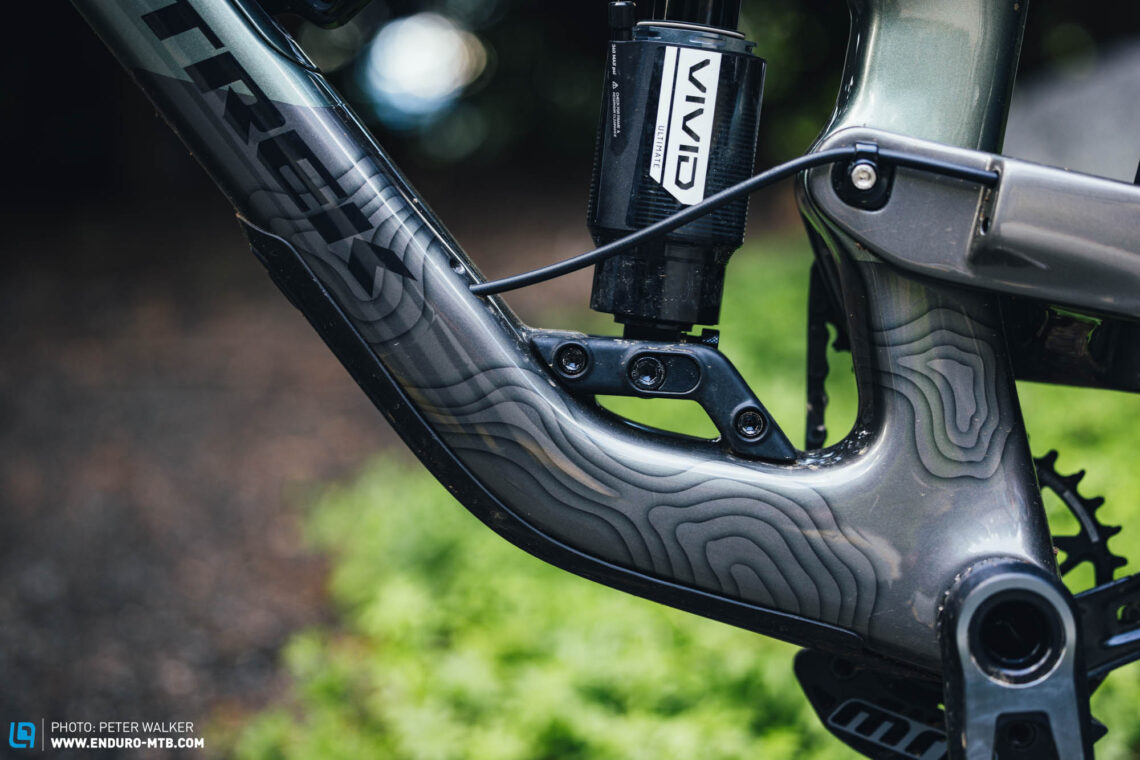
Trek deliver the new Slash with three different headset cups, which allow you to change the head angle by up to 1.5°. Of course, by altering the head angle you’ll also change the reach, bottom bracket height and stack height. The new Slash comes standard in the neutral setting. When swapping the cups, however, the lower one has to be installed with a bearing press, meaning that you can’t just quickly swap cups on the trailside. In the neutral setting, the Slash has a 63.3° head angle, which can be changed to either 62.6° or 64.1°. In addition, Trek forgo their usual Knock Block with the new Slash, which means that you don’t have a steering stop limiter.
The position of the bottom bracket allows engineers to achieve different chainstay lengths by using the same rear end, whereby sizes M/L and L share the same values. Simply put, all frame sizes share the same identical swingarm but rely on a slightly different bottom bracket position to allow for the size-specific effective chainstay length. The advantage of this system is that you can easily replace the rear end in case of damage.In size L, the Slash combines 488 mm reach with a short 435 mm seat tube, which offers a generous insertion depth for long-travel dropper posts. The seat tube is short across all sizes, ensuring sufficient freedom of movement on the trail.
The geometry of the new 2024 Trek Slash in the neutral setting
| Size | S | M | M/L | L | XL |
|---|---|---|---|---|---|
| Seat tube | 390 mm | 400 mm | 420 mm | 435 mm | 470 mm |
| Top tube | 547 mm | 578 mm | 605 mm | 627 mm | 658 mm |
| Head tube | 100 mm | 100 mm | 110 mm | 120 mm | 140 mm |
| Head angle | 63.5° | 63.5° | 63.5° | 63.5° | 63.5° |
| Seat angle | 78.1° | 77.8° | 77.3° | 77.1° | 76.7° |
| Chainstay | 429 mm | 429 mm | 434 mm | 434 mm | 439 mm |
| Wheelbase | 1.195 mm | 1.223 mm | 1.253 mm | 1.277 mm | 1.311 mm |
| Reach | 430 mm | 448 mm | 468 mm | 488 mm | 513 mm |
| Stack | 587 mm | 623 mm | 632 mm | 641 mm | 659 mm |
The new 2024 Trek Slash 9.9 XO AXS on the trail
For this review, we were able to ride the new Trek Slash 9.9 XO AXS 2024 in both size L and XL. We tested the bike over the course of several weeks, putting it through the wringer on the legendary trails of Whistler, Squamish and Della Creek, both on bike park trails and natural trails – and also managed to squeeze in a few laps with freeride legend Andrew Shandro. We also rode the new Slash (in size L) on our home trails around Stuttgart and on some techy Alpine gnar in Switzerland. Testing the new Slash in different frame sizes and countless locations gave us the opportunity to gather plenty of impressions.
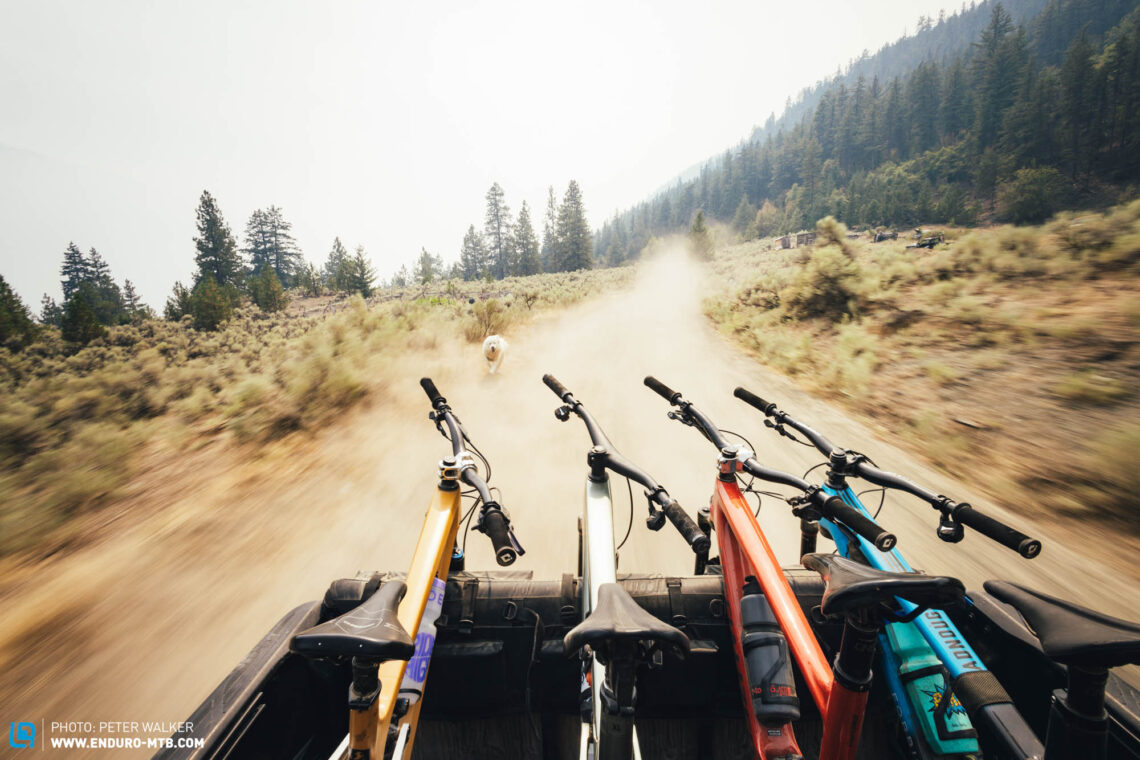
Needless to say, an aggressive enduro bike won’t earn you any uphill KOMs, and yet the new 2024 Trek Slash 2024 gets you to the trailhead without too much effort. The rear suspension only bobs slightly and generates plenty of traction on technical climbs, meaning that you can easily make your way to the top of the mountain without reaching for the Vivid’s climb switch. On steeper climbs, the front wheel remains planted on the ground, ensuring excellent steering precision. While on the first test laps the bike was totally quiet, with the idler pulley working discreetly in the background, this changed after a few days, with an increasingly loud rattling noise accompanying us on every climb.
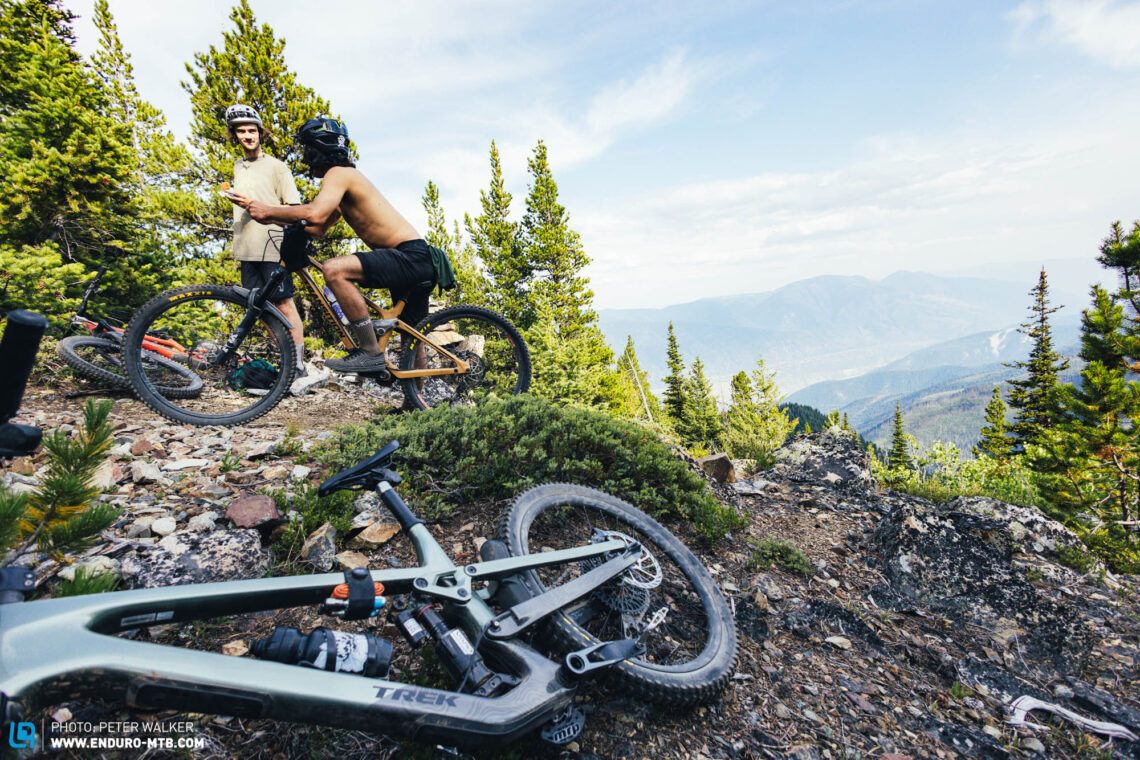
When gravity takes over, the first thing you’ll notice is the high front end and deeply integrated riding position. This inspires huge amounts of confidence, even on the gruellingly steep Canadian trails. The Slash makes you feel at ease from the get-go, encouraging you to keep your fingers off the brakes after just a few corners. If you do brake – which is inevitable from time to time – the rear suspension generates tons of traction without stiffening up excessively if you hit a large bump while decelerating. The wheelbase of the Slash grows noticeably less than with other high pivot bikes, remaining agile and playful even when fully compressed. Overall, the rear suspension provides plenty of support, allowing you to pop off ledges and kickers while at the same time offering enough reserves to cope with botched landings.
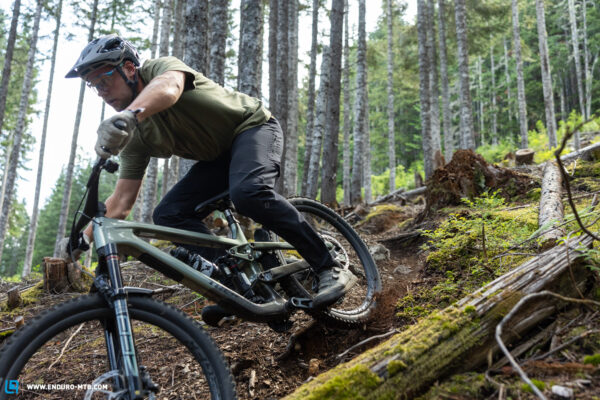

The new Slash has direct handling and reacts to steering input quickly and precisely. During this test, we swapped the original wheels and handlebars for alloy models, which helped mitigate the very direct ride feeling, ensuring more forgiving handling in slippery conditions. Even in open corners, the Trek sticks to the chosen line with great composure and doesn’t require you to actively weight the front wheel – and that’s despite the high front end! As a result, you’re always in a central riding position, which conveys huge amounts of confidence in all situations. Overall, the Trek makes you feel as if you had more travel on tap and at the same time is just as agile and playful as bikes with less travel. Trek also seem to have successfully addressed the typical drawbacks of high pivot bikes, like the sluggish handling and unbalanced suspension performance, which can result from the growing wheelbase.
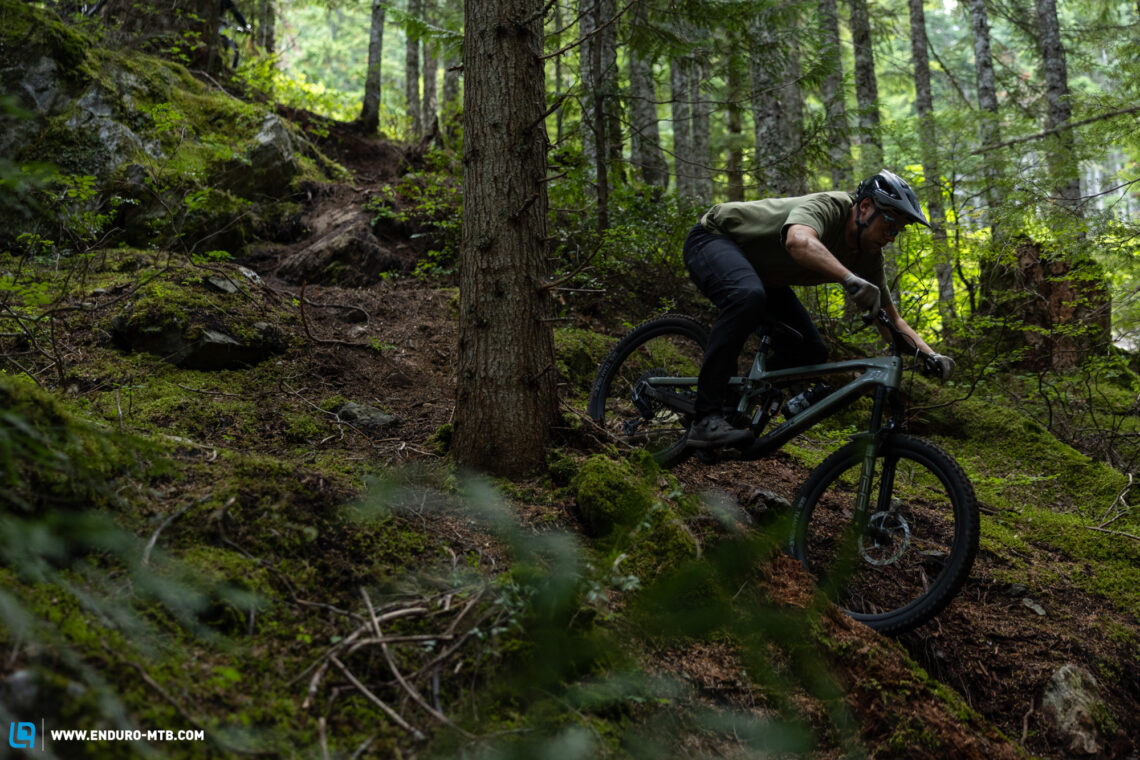
Who should take a closer look at the new 2024 Trek Slash?
The new Trek Slash is aimed at trail rippers, enduro racers, park rats and anyone who likes to get rowdy on gnarly trails. Provided you perform a few basic upgrades, like more robust tires and a tuneable cockpit, the new Slash offers a pretty sweet overall package – we’re pretty chuffed with it ourselves. Even on slower, narrower trails, it’s refreshingly nimble, while the excellent suspension allows you to generate speed by pumping through flow trails, which isn’t always a given with high pivot bikes. In our humble opinion, the Trek Slash 2024 is the next evolutionary stage of high pivot bikes, bringing all the advantages of a high pivot suspension design while at the same time eliminating most of its drawbacks.

Our conclusions about the new 2024 Trek Slash
The new Trek Slash 2024 offers agile, balanced handling and combines it with all the positive traits of a high pivot suspension design, ensuring excellent composure and a plush ride. If you like to open the taps on gnarly enduro trails, we recommend upgrading a few components. This will allow you to boost the Slash’s trail performance enormously with relatively little effort and at a reasonable price. The new Slash slaps a huge smile on your face, whether you’re going for a quick post-work ride on your home trails, racing enduro in the Alps or lapping park tracks – and also makes a great companion for the occasional flowing trail.
Tops
- Integrated, confidence inspiring riding position
- Combines excellent composure and agility
- Potent suspension provides plenty of pop and reserves
- Practical features like the integrated storage compartment and mini-tool
Flops
- Spec has some blemishes
- Idler pulley grinds lightly when pedalling uphill
For more info, visit Trek’s website.

Did you enjoy this article? If so, we would be stoked if you decide to support us with a monthly contribution. By becoming a supporter of ENDURO, you will help secure a sustainable future for high-quality mountain bike journalism. Click here to learn more.
Words: Peter Walker Photos: Sterling Lorence, Peter Walker





